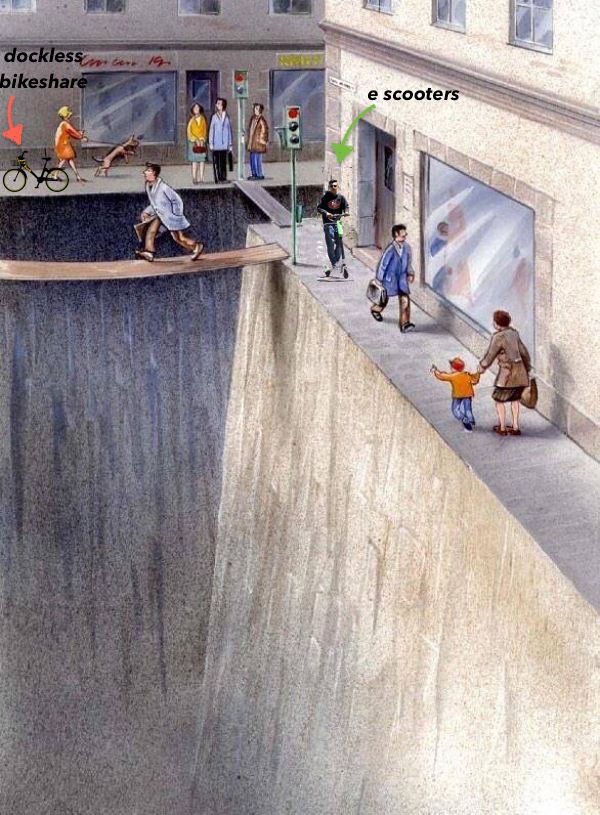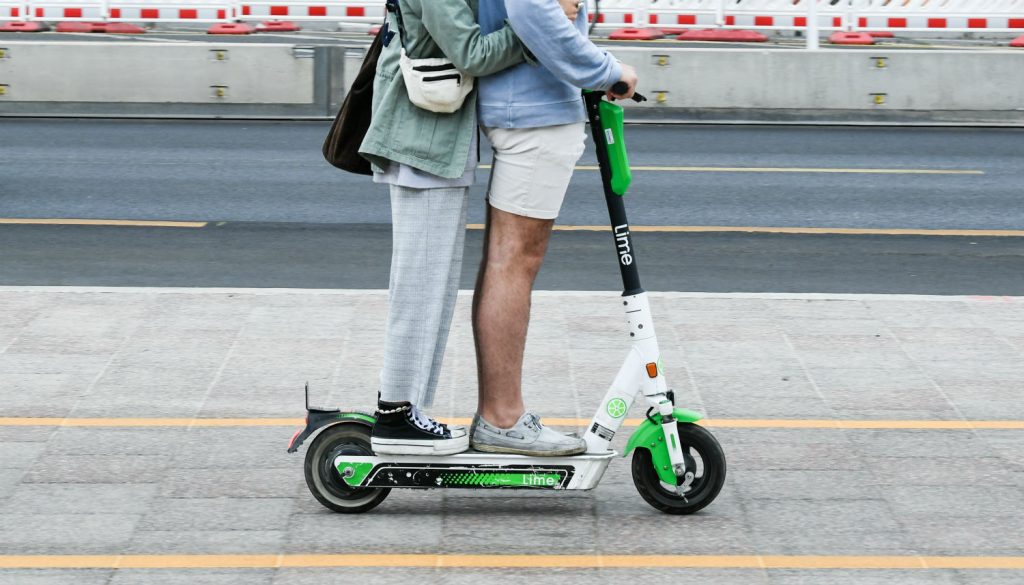e-Scooters: what do you think? Tell the council
Wellington City Council is doing a 6-month check-in on the e-scooters trial. What do you think? Tell them by 2 February!
Ah the scooters… We have views of course (search “scooters” on our site).
But to help you give your feedback on the trial, TW has gathered some food for your thought, to whet your appetite for sending in your feedback by February.
There’s a quick diner-style one, then some tasty quotes, then a full smorgasbord, all from very smart people. Finally, there’s a little after-dinner mint on Corporate Evil, courtesy of TW.
The Quick: Guy Marriage – architect, author and urbanist
- Great fun to use and they have changed the way that transport works in NZ cities.
- Yes helmets would make things safer, but also most people using scooters by renting informally will not have a helmet on them.
- Not safe to operate at speed on footpath when pedestrians are also using footpath (OK at other times, or at low speeds).
- Not safe to operate on roads at almost any speeds if there are cars present (20-30kmh is probably highest speed traffic could mingle with scooters).
- Not safe to operate to operate in a bus-lane due to gross inertia of buses: they can’t stop or dodge you.
- Law urgently needs adjusting, as the safest place to operate a scooter is currently in a cycle lane – however, currently the law says that the only place an e-scooter is banned, is a cycle lane. Clearly the law is an ass and needs to change.
- Urgent need for new lanes suitable and authorised to have both cycles and scooters – clearly separated from cars and pedestrians.
- Scooter lanes require a smooth surface with much less surface roughness than a bike lane – they are particularly susceptible to crashes with small obstructions such as pebbles or small kerbs. Only scooters with larger or softer wheels be authorised to operate – solution?
- Scooter companies need to take ownership of the way that scooters are left junked in piles outside shops and the Railway station at the end of each day. It’s a serious problem, as is the actual recycling issues with the scooters. Gross obsolescence is built in.

The survey again (closes 2 February)
The Quotes: Living Streets Aotearoa, and a disability advocate
Living Streets Aotearoa, walking (and accessibility) advocates, say:
“We need better data on pedestrians, on our footpaths and how to improve them for pedestrians. Meanwhile the government has allowed e-scooters and is working to get more vehicles onto our footpaths!
The 2004 Road Rule change that allowed mobility scooters onto footpaths could not have considered the electric scooters we see today, they weren’t around! A speed limit on footpaths was suggested but rejected. The safe speed on footpaths is walking speed for any vehicle user like mobility scooters or vehicles accessing a property – 5kms hour.”
Their president Andy Smith talks here to RNZ about what LSA call “The E-scooters on footpaths debacle”.

Another good quote here, from disability advocate Chris Ford writing in The Spinoff in Summer 2019 “Why disabled people are cheering the Lime ban“:
… it looks like Lime’s ability to successfully navigate our legal loopholes ended up trumping any consideration of the safety of pedestrians, of e-scooter users themselves, and of other users of the transport system, including motorists and cyclists.
Now the concerns of the disability community have been vindicated through nearly six months of actual experience. Disability community social media pages are full of people expressing anger and frustration about the Lime situation, including the need – as I’ve experienced myself – to dodge out of the way of a badly driven scooter.
…
I have to be honest: it’s no fun to be the so-called fun police. But anyone who identifies as a disabled person and lives in a Lime-using area will almost certainly be expressing relief today that the calls for greater restraint have finally been heard.
No doubt other members of the public who have had their own negative experiences with Lime e-scooters – either as users themselves, or as pedestrians who’ve had run-ins with them – will be expressing some relief too. Now, onto the fight for better regulation and standards that will benefit everyone, both e-scooter users and non-users alike.
The survey again (closes 2 February)
The Smorgasbord: Oliver Bruce, micromobility expert
I think it’s worth citing the substantial benefits that these vehicles bring to Wellington:
- Convenience: Electric micromobility services like this tend to work best in highly dense cities like Wellington providing a highly personalised point-to-point transport.
- Cost: Transport is New Zealanders’ third largest expense category. These services are comparably very cheap and there are strong arguments that they help address mobility poverty.
- Climate: Electric bikes and scooters produce only 1-3% of the emissions of comparable car trips – if we’re *really* serious about dealing with climate change (as I am), then this should be as actively encouraged as possible.
Thoughts on the scooter trial so far are as follows:
General perception:
- Scooting in Wellington is doing incredibly well for an early market – anecdotally we have some of the highest levels of wintertime utilisation on a Trips/Vehicle/Day in a market globally. This is attributable to:
- Novelty of a new form factor/service
- High density city with lower levels of car ownership than many cities around NZ
- The crappy bus reliability encouraging people to use the service!

Street Infrastructure:
In both cases below, WCC needs to get members of NZTA’s Innovating Streets for People team in to talk about the benefits of ‘trialling infrastructure’ as a means of making changes quickly.
We *need* better scooter/bike lane infrastructure. The current plan is nice, but with 30% increases in cycling in Wellington last year (not really scooters – the measuring points were Evans Bay Parade and Karori Tunnel – these increases are largely attributable to e-bikes) and the new scooters, we need to seriously reconsider the planned buildout for the cycleways, which are not-fit-for-purpose and quickly becoming overwhelmed. My recommended points to Mayor Foster about this were:
Have your officers prepare a proposal to do the short term trial scooter/bike lanes in Wellington for the council to review and vote on based on the suggested programme in the Let’s Get Welly Riding Vision.
2. Have your officers review to their cycling demand projections (that underpinned the cycling masterplan buildout) based on forthcoming research from the NZTA on the growth of non-traditional modes including micromobility (due Q2, 2020).
New lane infrastructure should be matched with scooter/bike parking multipurpose corrals for parking at a minimum of every 100m within the CBD to get these off the footpath. This can be done two ways:
1) trial some on council land in specific geographies (easy to deploy immediately)
2) repurpose car parks around the city for this (requires Traffic Resolutions which take 3-5 months to prepare)
It should be noted that while this is important, we will struggle with enforcement for a while as the vehicles are not yet intelligent enough to know if they’re in an ‘approved’ parking spot.

e-scooter hardware:
- The existing Segway ES4’s operated by both Flamingo and Jump are unfit for purpose as a shared scooter. They were originally designed as a consumer scooter, and have been retrofitted for shared micromobility services. They suffer from:
- An unsafe ‘tippy’ design because their batteries are all in the stem, not in the floor of the vehicle like more modern shared scooter designs.
- have insufficiently powerful regenerative brakes for the hilly terrain of Wellington (vs. mechanical brakes available on other shared scooter designs)
- wheels that are too small, making the likelihood of an accident on a non-smooth surface higher.
- Given the high capital commitments that operators have made to bring these to the city, and the relatively low levels of injury that we’ve seen in Wellington, we can chalk this up as a learning from this trial, but I’d strongly recommend that we stipulate the following for a post-trial scooter deployment:
- Mechanical (rather than purely re-generative) braking system with a brake handle, not button.
- Batteries in the bottom of the scooter, not only in the stem (which makes for a ‘tippy’ design)
- Larger wheels (minimum 9 inch)
For reference, both Lime and Jump already operates scooters that meet these criteria in other geographies, as do many of the other larger operators who would likely bid to participate in Wellington for a longer term permit.
e-Scooter trial operations:
- Keep two operators – it allows them to invest to build their business with some level of protection, but keeps them nimble if they have to compete. For reference, Paris (with 12 million residents) only has 4 operators.
- I recommend we move to a dynamic cap (ie. operators can operate as many scooters as they like, but need to achieve an average of 4 trips per vehicle per day over the trailing 30 day period), similar to Austin, Texas. This serves two purposes:
- it allows for a market-based solution for determining the ‘correct’ number of vehicles in the city based on whether residents actually use the scooters or not, as we do with taxis/rideshare operators, rather than resorting to an archaic quota system.
- lets operators build a more responsive business and achieve economies of scale if they’re finding demand in a city.

The after-dinner mint: corporate ethics and Uber
That’s enough from the smart people; it’s now your Talk Wellington editor here!
TL;DR: We can do micromobility – and carshare – just fine with companies who pay tax and aren’t evil.
See the references in this excellent thread below for why we reckon Wellington shouldn’t support Uber operating in our city.
What do you think? Tell Wellington City Council –
the survey closes 2 February
More on the city issues being fought through scooters:
- The e-scooters fight: it’s all on… on the footpath
- Scooters vs walking vs bikes: the Hunger Games of the street
- e-Scooters, dockless bikes: safety under siege!
- Frustrated about e-scooters AND cycleways? Rori iti – little roads will help everyone
Image credits:
- Banner image: Pinterest user pocket_lint
- Two people on a scooter – Alamy
- Scooters on footpath, Westwood Los Angeles ROBYN BECK/AFP/Getty Images)
- Scooter on fire – Olivier Laurent/The Washington Post via Getty Images
awesome. But bicycle will still be on top